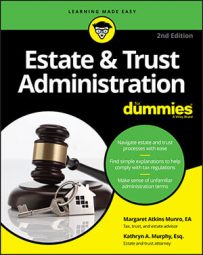Just because an employer, bank, brokerage firm, or other payer continues making payments to the decedent doesn’t necessarily mean that’s whose tax return they should go. As the administrator of the estate, you make the final determination of where these items rightfully belong — and you have the responsibility of reporting them correctly.
Because most taxpayers are cash basis (you don’t report items that you owe or that others owe to you), you should be able to determine pretty easily which tax return an item belongs on. If a check is dated after the date of death, it belongs to the estate, even if it’s payable to the decedent; checks dated through the date of death belong to the decedent.
The same is true for amounts owed by the decedent. If the decedent wrote and mailed the check, he or she gets the deduction; if you pay the bill after death, the deduction belongs to the estate, even if you paid the check from the decedent’s checking account (which is a major no-no).
As with any rules, exceptions exist. Property owned jointly with rights of survivorship (a form of joint ownership in which title passes automatically to the surviving joint owner(s)), and property owned as tenants by the entireties (ownership available only to spouses in which title passes automatically to the surviving spouse upon the first spouse’s death) transfer at the time of death to the surviving owner(s).
So income received after death belongs 100 percent to the surviving joint owner(s) or surviving tenant by the entirety. Likewise, mortgage payments owed on property held jointly with rights of survivorship and as tenants by the entireties become the sole liability of the survivor(s). If property is owned jointly as tenants in common, the scenario changes.
At death, the deceased joint owner’s heirs become additional joint owners of the property and now automatically receive the decedent’s share of the income together with the decedent’s share of any debts owed on that property.
The estate often receives income for months — sometimes years — after the decedent’s death, with checks still payable to the decedent personally. Don’t hesitate to deposit these checks into the estate’s accounts — that’s where they belong, after all. You have to notify the IRS, however, that the estate is going to declare this income.
You can do this by completing a nominee Form 1099 and filing it with the IRS. Just show the decedent (with his or her Social Security number) as the Payer, and the estate (with its TIN) as the Recipient. (To obtain a 1099, just call 800-829-3676.) If you failed to file nominee 1099s, you can still let the IRS know where the income you’re reporting was originally reported to them.
Merely place a notation on the estate’s tax return showing that the estate received the income in the name and Social Security number of the decedent.
Finally, although most itemized deductions are equally deductible on a Form 1040 or Form 1041, you may deduct medical expenses only on Form 1040, not on Form 1041. If you pay final medical bills for the decedent, you don’t need to lose those deductions. The IRS allows even cash-basis taxpayers to deduct medical expenses paid within a year after death on the decedent’s final Form 1040.

